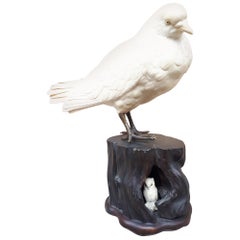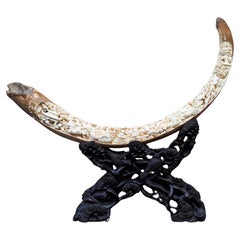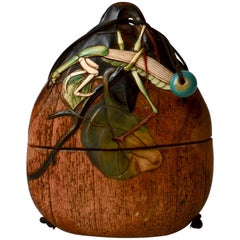Ivory Sculptures and Carvings
4
to
2
2
4
4
4
3
1
149
1,841
1,260
917
886
4
4
2
2
Material: Ivory
Japan 1890 Meiji Carved Figure of Fortune God Daikoku As a Farmer With Coins
Located in Miami, FL
A Japanese carved sculpture of Daikoku.
Magnificent sculpture of the god of the fortune Daikoku, created in Japan during the Meiji period, circa 1890. The carving depicts the Japane...
Category
1890s Japanese Meiji Antique Ivory Sculptures and Carvings
Materials
Ivory
Ivory Okimono by Kofu, Japan Meiji era
Located in Saverne, Grand Est
Rare okimono carved in the thickness of an elephant tusk depicting a life-size pigeon. It stands on a hollow trunk, inside which hides an owl.
A small 4mm...
Category
1880s Japanese Meiji Antique Ivory Sculptures and Carvings
Materials
Ivory
Pair Matching Ivory Chinese Dogs of Foo Matchstick Holders Silver Bases
Located in High Wycombe, GB
A Delicate Pair Of Ivorine Dogs of Foo Matching Matchstick Box Holders.
Bases Have Silver Mark Stamp.
Chinese guardian lions, or imperial guardian lions, are a traditional Chinese a...
Category
20th Century Chinese Chinese Export Ivory Sculptures and Carvings
Materials
Silver
Chinese 1900 Qing Dynasty Bodhisattva Altar Temple-Pagoda In Wood And Carvings
Located in Miami, FL
Buddhist altar temple-pagoda from the Qing Dynasty (1644-1911).
Fabulous and very rare, East Asian, Buddhist Altar Temple-Pagoda. It was created in China during the late Qing Dynast...
Category
1890s Chinese Qing Antique Ivory Sculptures and Carvings
Materials
Wood, Ivory
Related Items
Japanese Meiji Noh Mask in Carved Wood
Located in New York, NY
Japanese early Meiji period Noh theater mask made of carved wood with gofun layers. The piece was made in Japan in circa 1880 and is signed on the back. In great antique condition wi...
Category
1880s Japanese Meiji Antique Ivory Sculptures and Carvings
Materials
Wood
Japanese Meiji Period Carved Wood Okimono Man with Rabbits
Located in Newark, England
The charming figure, carved from a single piece of wood is exceptionally carved showing the male figure with humorous expression holding two Rabbits one by the ears and the second under his arm. A third Rabbit stands at the feet of the male looking up, each rabbit with a different expression. The male figure is wearing traditional Japanese attire with his hair tied back stood upon a naturalistic base. The figure dates to the Meiji Period (1868-1912) circa 1900.
Notes The Rabbit is one of the 12 animals to feature in the Japanese Zodiac signs which follows the Chinese astrological system along with the Rat, Ox, Tiger, Rabbit, Dragon, Snake, Horse, Goat, Monkey, Rooster, Dog, Pig. Such division is connected with the Jupiter cycle around the Sun, which lasts about 12 years. As 2023 is the year of the Rabbit...
Category
Early 1900s Japanese Meiji Antique Ivory Sculptures and Carvings
Materials
Wood
Japanese Meiji Bunraku Ningyo Puppet
Located in New York, NY
Japanese Meiji period puppet for the traditional Bunraku ningyo joruri puppet theater. The piece has a carved wood head and is adorned with richly detai...
Category
Early 1900s Japanese Meiji Antique Ivory Sculptures and Carvings
Materials
Textile, Wood
Pair of Chinese Black Marble Contemporary Facing Foo Dogs Guardian Lions
Located in Yonkers, NY
A pair of contemporary Chinese black marble left and right facing foo dogs guardian lions on rectangular bases. Created in China during the 21st century, this pair of black marble gu...
Category
21st Century and Contemporary Chinese Ivory Sculptures and Carvings
Materials
Marble
Japanese Paloma Wood Carving Okimono of Jurojin
Located in New York, NY
A Japanese carved paloma wood Okimono of Jurojin (god of longevity with a turtle). A symbol of long life, the sculpture also depicts a young boy representing the beginning of life. Carved from one piece of boxwood with a beautiful rich patina. Jurojin originated from the Chinese Daoist god, the old man of the South Pole, he may have been a historical figure of the Northern Song Dynasty...
Category
Late 19th Century Japanese Meiji Antique Ivory Sculptures and Carvings
Materials
Boxwood
Two Chinese Wood Lion Foo Dogs Incense Holder
Located in North Hollywood, CA
Two Chinese wood Foo Dogs Incense holder burners.
Featuring a pair of highly detailed lion foo dogs, one male and one female which were thought to protect the home from harmful spiritual influences and harmful people that might be a threat.
The Foo Dogs...
Category
Late 20th Century Chinese Chinese Export Ivory Sculptures and Carvings
Materials
Wood
Japan 1890 Meiji Period Rare Carved Okimono Of A Father And Son Playing Signed
Located in Miami, FL
Japanese Okimono sculpture of a father and son.
Very rare and highly detailed sculpture, created during the meiji period (1868-1912) in the imperial Japan, circa 1890. This sculptural Okimono is very well realized and exceptionally proportionate. Show the figures of a father and a son playing, with happiness and smiling. The father hold a big basket at his back and both personages are wearing kimonos richly engraved.
This piece was made from a carving with exceptional craftsmanship and intricate details. This sculpture stand itself on his own base and have all retain of the applied ochre ink accents.
Measures: 130 mm by 45 mm by 53.3 mm (5.1 x 1.75 x 2.1 inches).
Weight: 81.30 grams.
Note: This kind of family scene is very rare to seen in nineteenth century japanese iconography.
Okimono
Is a Japanese term meaning for display an ornament; art object; or decorative object, usually displayed in a tokonoma or butsudan "Buddhist altar". It is an ornament or figure, especially one placed in a guest room. An okimono may be a small Japanese carving, similar to but larger than a netsuke. Unlike the netsuke, which had a specific purpose, the okimono is exclusively decorative and was displayed in the tokonoma. During the Meiji period, many okimonos were made for export to the West.
Meiji Period
This is an era of Japanese history that extended from October 23, 1868 to July 30, 1912.The Meiji era was the first half of the Empire of Japan, when the Japanese people moved from being an isolated feudal society at risk of colonization by Western powers to the new paradigm of a modern, industrialized nation state and emergent great power, influenced by Western scientific, technological, philosophical, political, legal, and aesthetic ideas. As a result of such wholesale adoption of radically different ideas, the changes to Japan were profound, and affected its social structure, internal politics, economy, military, and foreign relations...
Category
1890s Japanese Meiji Antique Ivory Sculptures and Carvings
Materials
Wood, Paint
H 2.1 in W 5.1 in D 1.75 in
Chinese Pair Hand Carved Red Hardstone Mounted Foo Dogs
Located in Bishop's Stortford, Hertfordshire
A delightful and well carved pair Chinese red hard stone dog of Foo figures of miniature size dating from the first half of the 20th century. The figures stand raised on a solid hand...
Category
20th Century Chinese Ivory Sculptures and Carvings
Materials
Ceramic
Large Japanese Meiji Bronze Lidded Urn, 19th Century
Located in Bishop's Stortford, Hertfordshire
A large and stylish antique Japanese Meiji bronze lidded twin handle urn standing on a rounded plinth base with tongue and grotesque head formed legs with dragon handles and a flat c...
Category
Early 20th Century Japanese Meiji Ivory Sculptures and Carvings
Materials
Bronze
Finely Carved Japanese Okimono on Stand
Located in Atlanta, GA
An antique Okimono (Japanese means artsy display ornament object) displayed on a small custom wood stand from Meiji Period circa early 2oth century. T...
Category
Early 20th Century Japanese Japonisme Ivory Sculptures and Carvings
Materials
Wood
A pair of 19th Century carved Foo temple dogs or Chinese guardian Lions
Located in London, GB
Chinese guardian lions, or imperial guardian lions, are a traditional Chinese architectural ornament. Typically made of stone, they are also known as stone lions or shishi (石獅; shíshī). They are known in colloquial English as lion dogs or foo dogs / fu dogs. The concept, which originated and became popular in Chinese Buddhism, features a pair of highly stylized lions—often one male with a ball and one female with a cub—which were thought to protect the building from harmful spiritual influences and harmful people that might be a threat. Used in imperial Chinese palaces and tombs, the lions subsequently spread to other parts of Asia including Japan (see komainu), Korea, Philippines, Tibet, Thailand, Myanmar, Vietnam, Sri Lanka, Nepal, Cambodia, Laos, and Malaysia.
There has been extensive interaction between Chinese mythology and Confucianism, Taoism, and Buddhism. Elements of pre-Han dynasty mythology such as those in Classic of Mountains and Seas were adapted into these belief systems as they developed (in the case of Taoism), or were assimilated into Chinese culture (in the case of Buddhism). Elements from the teachings and beliefs of these systems became incorporated into Chinese mythology. For example, the Taoist belief of a spiritual Paradise became incorporated into mythology as the place where immortals and deities used to dwell. Sometimes mythological and religious ideas have become widespread across China's many regions and diverse ethnic societies. In other cases, beliefs are more limited to certain social groups, for example, the veneration of white stones by the Qiang. One mythological theme that has a long history and many variations involves a shamanic world view, for example in the cases of Mongolian shamanism among the Mongols, Hmong shamanism among the Miao people, and the shamanic beliefs of the Qing dynasty from 1643 to 1912, derived from the Manchus. Politically, mythology was often used to legitimize the dynasties of China, with the founding house of a dynasty claiming a divine descent.
Mythology and philosophy.
Further information: Chinese philosophy
True mythology is distinguished from philosophical treatises and theories. Elaborations on the Wu Xing are not really part of mythology, although belief in five elements could appear. The Hundred Schools of Thought is a phrase suggesting the diversity of philosophical thought that developed during the Warring States of China. Then, and subsequently, philosophical movements had a complicated relationship with mythology. However, as far as they influence or are influenced by mythology, divides the philosophical camps into two rough halves, a Liberal group and a Conservative group. The liberal group being associated with the idea of individuality and change, for example as seen in the mythology of divination in China, such as the mythology of the dragon horse that delivered the eight bagua diagrams to Fu Xi, and methods of individual empowerment as seen in the Yi Jing (Book of Changes). The Liberal tendency is towards individual freedom, Daoism, and Nature. The relationship of the Conservative philosophies to mythology is seen in the legendary Nine Tripod Cauldrons, mythology about the emperors and central bureaucratic governance, Confucianism, written histories, ceremonial observances, subordination of the individual to the social groups of family and state, and a fixation on stability and enduring institutions. The distinction between the Liberal and Conservative is very general, but important in Chinese thought. Contradictions can be found in the details, however these are often traditional, such as the embrace by Confucius of the philosophical aspects of the Yi Jing, and the back-and-forth about the Mandate of Heaven wherein one dynasty ends and another begins based according to accounts (some of heavily mythological) where the Way of Heaven results in change, but then a new ethical stable dynasty becomes established. Examples of this include the stories of Yi Yin, Tang of Shang and Jie of Xia or the similar fantastic stories around Duke of Zhou and King Zhou of Shang.
Mythology exists in relationship with other aspects of society and culture, such as ritual. Various rituals are explained by mythology. For example, the ritual burning of mortuary banknotes (Hell Money), lighting fireworks, and so on.
A good example of the relationship of Chinese mythology and ritual is the Yubu, also known as the Steps or Paces of Yu. During the course of his activities in controlling the Great Flood, Yu was supposed to have so fatigued himself that he lost all the hair from his legs and developed a serious limp. Daoist practitioners sometimes incorporate a curiously choreographed pedal locomotion into various rituals. Mythology and practice, one explains the other: in these rituals, the sacred time of Yu merges with the sacral practice of the present.
Various ideas about the nature of the earth, the universe, and their relationship to each other have historically existed as either a background or a focus of mythologies. One typical view is of a square earth separated from a round sky by sky pillars (mountains, trees, or undefined). Above the sky is the realm of Heaven, often viewed of as a vast area, with many inhabitants. Often the heavenly inhabitants are thought to be of an "as above so below" nature, their lives and social arrangements being parallel to those on earth, with a hierarchical government run by a supreme emperor, many palaces and lesser dwellings, a vast bureaucracy of many functions, clerks, guards, and servants. Below was a vast under ground land, also known as Diyu, Yellow Springs, Hell, and other terms. As time progressed, the idea of an underground land in which the souls of the departed were punished for their misdeeds during life became explicit, related to developments in Daoism and Buddhism. The underground world also came to be conceived of as inhabited by a vast bureaucracy, with kings, judges, torturers, conductors of souls, minor bureaucrats, recording secretaries, similar to the structure of society in the Middle Kingdom (earthly China).
Chinese temple Dogs...
Category
1860s Chinese Chinese Export Antique Ivory Sculptures and Carvings
Materials
Hardwood
H 11.42 in W 20.48 in D 7.49 in
Japanese bronze okimono turtle (sculpture)
Located in PARIS, FR
Okimono sculpture of a bronze turtle, tail retractable.
In Japan, the turtle (kame) is a symbol of longevity and an auspicious animal.
It is believed to bring ten thousand years of h...
Category
Late 19th Century Japanese Japonisme Antique Ivory Sculptures and Carvings
Materials
Bronze
Previously Available Items
Carved Mammoth Ivory Tusk, Chinese Crafts
Located in Saverne, Grand Est
Large mammoth tusk and its wooden support, all finely hollowed out and carved.
An exceptional piece that will delight any collector of Asian art. Much more impressive in real life th...
Category
20th Century Chinese Ivory Sculptures and Carvings
Materials
Ivory
Inro, Japanese, 19th Century
Located in Stockholm, SE
An inro, Japanese, made of wood and with inlays of colored ivory in the shape of a grasshopper and partly lacquered, 19th century.
An inro is a traditional Japanese case for holdi...
Category
19th Century Japanese Antique Ivory Sculptures and Carvings
Materials
Ivory, Wood, Lacquer
Chess Set
Located in Houston, TX
Indian bone pieces carved probably in Burma, and more than likely for Chinese carvers for an export. Natural bone and dyed red. The chess set is 19th century. Some repairs and age cracks. The king stands at 3 3/4 "high. The carving patters consist of flowers and more complex Chinese scenes. Fine wood chess...
Category
Mid-19th Century Indian Modern Antique Ivory Sculptures and Carvings
Materials
Ivory, Wood
Delightful Standing Woman Figure from Japan
Located in Berlin, DE
A very fine carving from Japan, Meiji period circa 1900. On rectangular wooden base. Rich gilded, with inlaid mother-of-pearl. Hands, feet, head and a pole ...
Category
Late 19th Century Japanese Japonisme Antique Ivory Sculptures and Carvings
Materials
Gold
Read More
12 Calming Spaces Inspired by Japanese Design
From cherry-blossom-adorned walls paired with glamorous lighting to wood-paneled ceilings above checkerboard-patterned chairs, these 12 spaces seamlessly blend Eastern and Western aesthetics.
Rodrigo Rivero Lake’s Mexico City Showroom Is a Museum-Worthy Trove of Spanish Colonial and Asian Antiques
The dealer and curator has spent the past 50 years amassing a collection of exceptional art, furniture and architectural elements that trace the cultural influence of the Spanish empire from Europe to the Americas and beyond.
Recently Viewed
View AllMore Ways To Browse
Ancient Asian Lamps
Hearth Hook
Indian Carving Stone
Chinese One Hundred Treasures
Fine Art Precious Stones Sculpture
Wood Mandalay Buddha Statue
Japanese Samurai Wood Block
Koi Fish Lantern
Ming Dynasty Jewelry
Bowenite Sculpture
Erotic Netsuke
Indian Sandstone Fragment
Jade Burners
Jade Incense Burner
Japanese Horse Bell
Paper Mache Buddha
Gilded Tibetan Buddha Statues
Handmade Chinese Wooden Box







